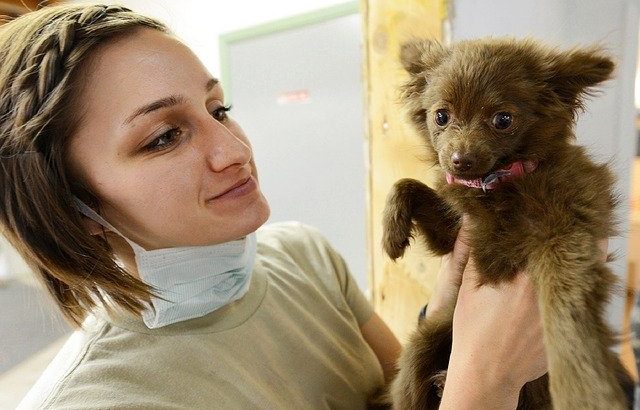What Is a Veterinary Assistant?
When exploring the different professions in the veterinary industry, you’ll probably come across veterinary assistants. According to the American Veterinary Medical Association (AVMA) there are about 120,000 licensed veterinarians in the United States. Like doctors, these veterinarians often require assistance when treating their patients. To learn more about veterinary assistants, including their education requirements, responsibilities and more, keep reading.
Overview of Veterinary Assistants
Not to be confused with a veterinary technician, a veterinary assistant is a worker who helps a veterinarian with his or her daily tasks. They typically work under the supervision, as well as guidance, of a professional veterinarian. When a client brings his or her pet to a veterinary clinic, the veterinary assistant will help the veterinarian diagnose and treat the pet. Basically, veterinary assistants are there to help veterinarians perform their regular duties, which means attending to and caring for clients’ pets.
Veterinary Assistant Responsibilities
Veterinary assistants have a myriad of responsibilities. With that said, the exact responsibilities vary depending on the veterinarian for whom the assistant works. Some veterinarians are more restrictive regarding the tasks to which they give their assistants. While some veterinarians only allow their assistants to perform a select few tasks, others provide their assistants with greater freedom. If you’re interested in becoming a veterinary assistant, you should familiarize yourself with some of their common responsibilities.
Some of the most common responsibilities of veterinary assistants include the following:
- Bathing pets
- Clipping pets’ nails
- Restraining aggressive pets
- Feeding or giving treats to pets
- Weight pets
- Take temperatures of pets
- Caring for boarded pets
- Walking pets
- Providing emergency treatment
- Drawing blood or tissue samples
- Consulting with pets’ owners
- Sterilizing equipment for the veterinarian
- Administering medication
Veterinary Assistant Education
How do you become a veterinary assistant exactly? Unlike veterinarians, as well as veterinary technicians, no formal education is required to secure a job as a veterinary assistant. Many veterinary assistants, in fact, only receive on-the-job training. The veterinarian for whom you work will typically train you on how to perform some or all of the tasks listed above.
You can increase your chances of securing a job as a veterinary assistant by earning a certificate. While certification isn’t a prerequisite for becoming a veterinary assistant, it will make you a more attractive candidate, meaning veterinarians are more likely to hire you. Certifications for veterinary assistants are offered by the American Association for Laboratory Animal Science (AALAS) as well as the National Association of Veterinary Technicians in America (NAVTA). Classes are typically about a year long, and assuming you complete them, you’ll become certified. At minimum, however, you’ll need a high school diploma or GED to secure a job as a veterinary assistant. Certification simply makes you a more attractive candidate while also providing new career opportunities in the veterinary industry.

Veterinary Assistant Salaries
How much can you earn as a veterinary assistant? According to the U.S. Bureau of Labor Statistics (BLS), the median salary for veterinary assistants in the United States is $27,540 per year. Of course, many veterinary assistants earn more than the median. A report published by USA Today indicates that top-earning veterinary assistants earn over $36,000 per year.
It’s also worth noting that there’s strong demand for veterinary assistants. From 2018 to 2028, the BLS predicts that 17,600 new jobs for veterinary assistants will be created. Based on those numbers, the rate of growth for veterinary assistant jobs in the United States is about 19% higher than that of other jobs.
Veterinary assistants are in strong demand — and there’s no signs of this changing anytime soon. All veterinarians need help to perform their daily tasks. Therefore, you can rest assured knowing that veterinary assistants are sought after. As long as there are veterinary clinics, there will be plenty of available jobs for veterinary assistants.
Furthermore, securing a job as a veterinary assistant can help you develop the skills needed for other jobs in the veterinary industry. After working as a veterinary assistant, for example, you may decide that you’d like to become a veterinary technician. With your newfound experience, you’ll have an easier time making this professional transition.
Veterinary Assistant Work Schedule
As a veterinary assistant, you’ll typically work the same or similar hours as veterinarians. Some veterinary assistants work full time, whereas others work part time. Regardless, you’ll typically be required to work when the veterinary clinic is open.
Since pets can experience medical emergencies at any time, you may be required to work some weekends or holidays as a veterinary assistant. If a client’s pet experiences a medical emergency, the veterinarian may call you in to help.
In Conclusion
Veterinary assistants are workers who help veterinarians perform their daily tasks. They provide assistance to veterinarians by bathing clients’ pets, clipping their nails, restraining aggressive pets and more. Veterinarian assistants are in strong demand with a growth rate that’s 19% higher than the national average.

